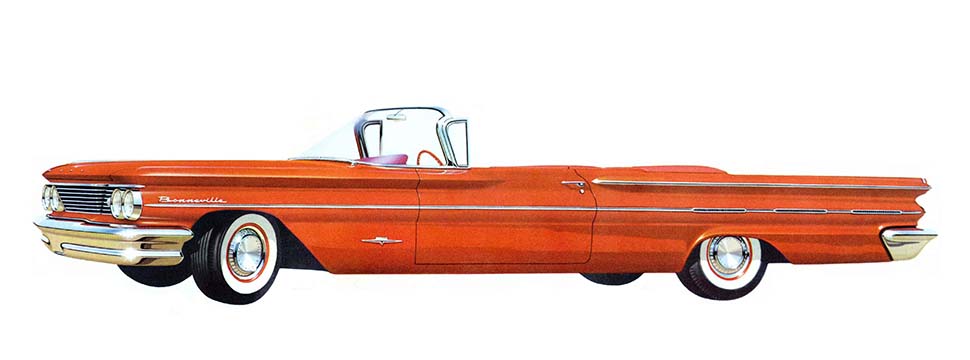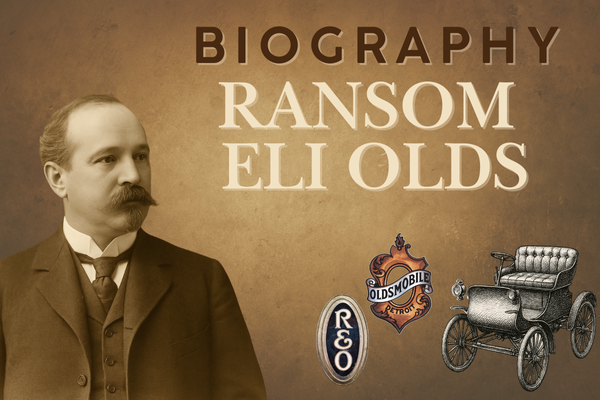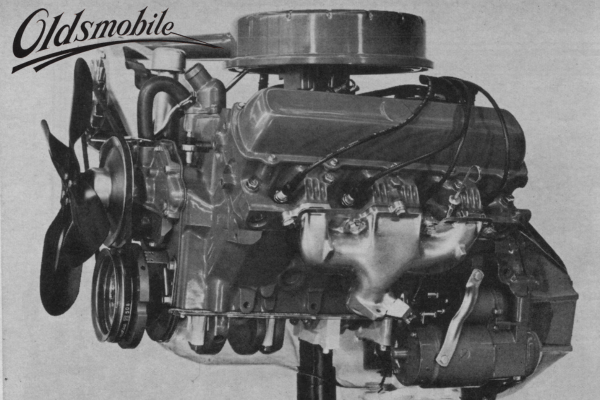The term “Safari” remained Pontiac’s nomenclature for a station wagon. All 1960 Safaris were four-door types and nine-passenger, three-seat, versions had power tailgate windows and rear-facing folding seats. Safaris had distinctive single taillamps and rear decor trim. “Amble Wagons” were low-cost professional cars built off of a standard Pontiac station wagon chassis by the Automotive Conversion Corp., Troy, Mich.
The term “Vista” meant four-door pillarless hardtop. The term “Sport Sedan” meant two-door pillared coupe. “Starlight” was two-tone paint costing $40 in regular colors or $52 in special colors.
A four-speed manual floor mounted transmission became available in mid-year. Most four-speeds went to professionally-driven NASCAR vehicles and drag racers. The unit was the same one used by Corvettes and Chevrolets that retailed for $188.30.
Production declined from the 1959’s 382,940 to 370,701, not a huge loss. GM was readying the new “small” A-Body car for introduction in 1961. Also in the wings wa the new mid-size Tempest, and Pontiac felt these two offerings would add to sales.
Historical Footnotes:
Jim Wangers took the NHRA Top Stock Eliminator title in a 1960 Pontiac, and Catalinas took checkered flags in three major NASCAR races and four Grand Nationals. Mickey Thompson set a World Land Speed Record of 363.67 mph in the Challenger I, a Pontiac powered streamliner.
Chassis Information
- Wheelbase: Series 21, 23 and 27 – 122″, Series 24 and 28 – 124″.
- Overall length: Series 21 – 213.7″, Series 24 and 28 – 220.7″, Series 21 Station Wagons and 27 Safari – 213.7″.
- Front tread: (All) 63.7″.
- Rear tread: (All) 64.0″.
- Tires: Coupes and Sedans 8.00 x 14 Station wagons & all w/Air conditioning 8.50 x 14. 8.50 x 14 available at extra cost on all lines in place of 8.00 x 14.
Models Offered
SERIES 21
Catalinas had plain beltline moldings, “Catalina” in script on the front fenders, and “Pontiac” in block letters on the belt latch panel. Standard features include turn signals, an oil filter, five tubeless tires, and courtesy lamps on convertibles.
SERIES 23
Venturas had plain belt moldings, “Ventura” in script on the front fender, and “Ventura” in block letters on the trunk latch panel.
Venturas had all Catalina features plus a custom steering wheel, electric clock, DeLuxe wheel discs, full carpeting, triple-tone Morrokide seats, right-hand ashtrays, and special decor moldings.
SERIES 24
Star Chiefs continued to be built on the long, 124″ wheelbase using the Catalina two-barrel V-8 for base power. They had Star Chief” in script on the front fender and “Star Chief” in block letters on the trunk latch panel. No aftermarket cars were built off of the Star Chief platform, although some may have had Star Chief trim.
Star Chiefs had the same regular equipment as Venturas plus dual-speed wipers. Distinguishing touches included Star Chief front fender scripts and four stylized stars at the rear of the lower belt line moldings
Regular equipment included all standard Catalina features plus two-speed electric wipers, DeLuxe steering wheel, electric clock, DeLuxe chrome wheel covers, and loop-pile Lurex-flexed carpeting.
SERIES 27 (Wagons) and 28
Pontiac’s top-line Bonneville was identified by “Bonneville” in script on the front fenders, “Bonneville” in block lettering on the deck latch panel, beltline moldings ending in three dashes of chrome at the rear, and a V-shaped crest on the lower front fenders.
All Bonnevilles had rear foam seat cushions, padded dashboards with walnut face inserts, courtesy lamps, and four-barrel V-8s in addition to all standard features found in lower-priced Pontiacs. All-Morrokide seat coverings were standard, and leather was available as an option.
Engines
Engine Options and Availability
- Options and availability listed in the “Engines” tabs above
Power Train Options
- A column shift three-speed manual transmission was standard.
- Super Hydra-Matic (Strato-Flight) transmission was $231.34 extra.
- A four-speed manual floor mounted transmission became available in mid-year, though not as a regular production option (“RPO”)
- Dual exhausts ($31) when not standard.
- The Tempest 66E option or ‘425E’ two-barrel 215 horsepower economy engine was optional on all models at no extra cost, but only with Hydra-Matic.
- The Bonneville four-barrel carburetor was $23.94 extra in other lines.
- Tri-Power on the standard 10.75:1 compression block option Bonneville ($89) Star Chief ($99) Ventura ($132) Catalina ($142).
- Tri-Power on the Tempest 425-A block with 10.75:1 compression Bonneville ($316) Star Chief ($326) Ventura ($359) Catalina ($369).
- Four-barrel induction on the Tempest 425-A V-8 Bonnevillw ($230) Star Chief ($251) Ventura ($273) Catalina ($294).
- Rear axle ratios: (Hydra-Matic) 3.08:1 ; (Optional Hydra-Matic) 3.23:1 ; (Synchromesh) 3.42:1 ; (Optional Synchromesh) 3.64:1 ; (425E Economy Engine) 2.69:1 (Optional Economy) 2.87:1 (dealer installed) 3.90:1 and 4.10:1.
- Safe-T-Track non-slip differential ($43).
Body Paint Color Codes
Significant Options
- Air-conditioning ($430).
- Aluminum 8-lug hubs and drums ($107).
- Bucket seats ($100).
- Circ-L-Aire heater/defroster ($43).
- Continental spare tire and cover ($258).
- Custom steering wheel ($15).
- Custom wheel discs ($17-32);
- DeLuxe wheel discs ($16).
- Direct Aire heater defroster ($94).
- Electric antenna ($30)
- E-Z-Eye Glass ($43).
- Luggage carrier ($99).
- Magi-Cruise ($13).
- Padded dash ($19).
- Power brakes ($43).
- Power steering ($108).
- Power windows 2-doors ($58) 4-doors ($106).
- Radio, Sportable ($129).
- Radio, Super DeLuxe ($89).
- Radio, Wonder Bar ($125).
- Rear seat speaker ($14).
- Remote control mirror ($12).
- Safeguard speedometer ($15).
- Under hood utility lamp ($7).
- Windshield washer ($13).



















